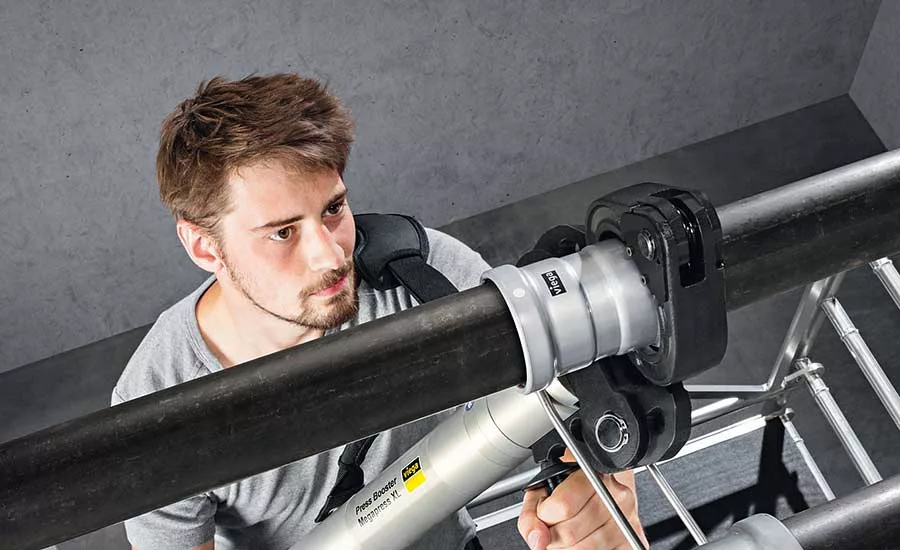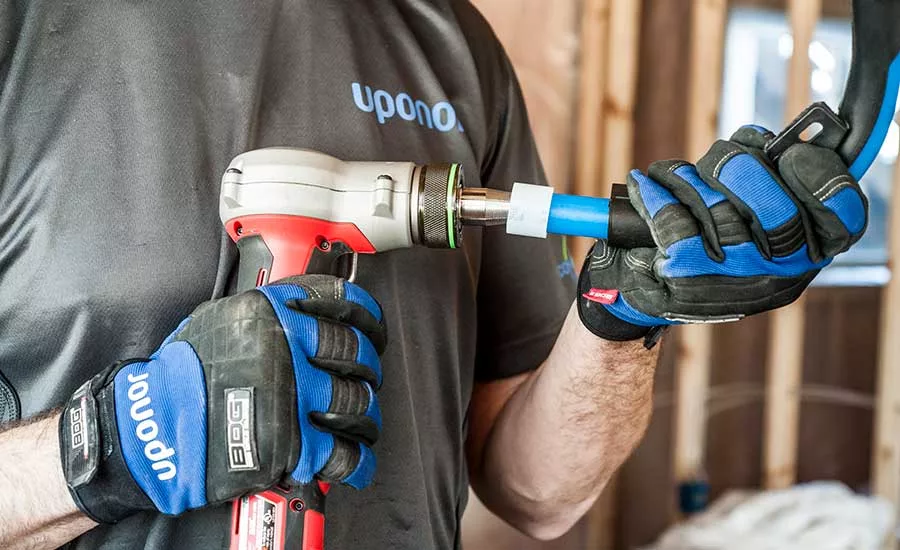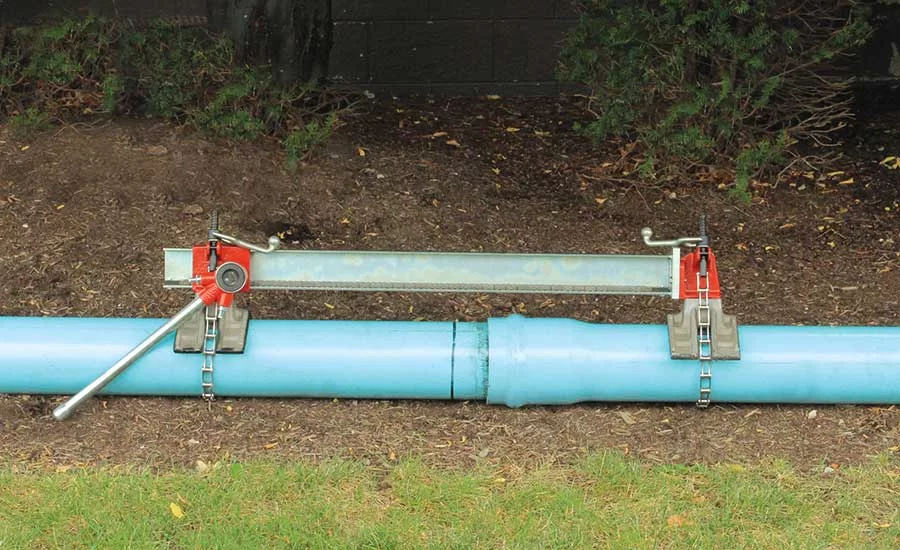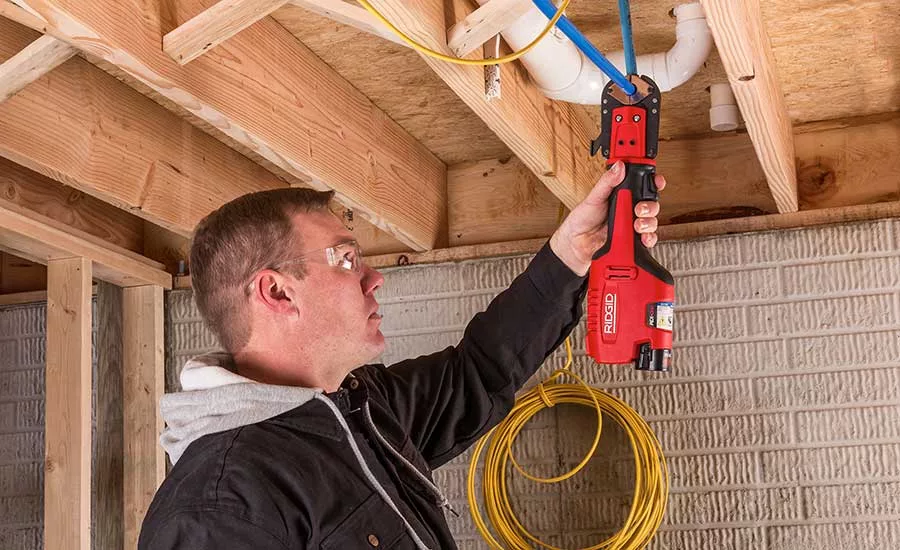A to Z pipe-joining methods
With all the different piping materials out there it can be hard to keep track of what is used where when entering the industry.

For metallic press systems, Viega offers and recommends jaws, rings, boosters and hydraulic pressing tools for imperial sizes 1/2 to 4 inches. Photo courtesy: Viega

Press technology, such as Milwaukee Tool's M18 FORCE LOGIC press tool, continues to grow in popularity. These tools allow users to work quickly and efficiently Photo courtesy: Milwaukee Tool

Making a 1/2-inch ASTM F1960 ProPEX connection from Uponor requires the use of one simple expansion tool from Milwaukee Tool. Photo courtesy: Uponor

With 28-to-1 leverage, one person can join PVC pipe up to 16-inch gasketed or up to 12-inch solvent cement joints using a Reed plastic pipe joiner. Photo courtesy: REED

The RIDGID PEX-One 12V battery PEX tool is purposely built for one-handed use. Photo courtesy: RIDGID
With all the different piping materials out there it can be hard to keep track of what is used where when entering the industry.
That is where guides such as the Online Piping & Usage Specification website, a product of the Mechanical Contracting Education & Research Foundation, come in handy. It was developed and introduced in 2008 as a resource for basic information regarding common piping systems, materials and joining methods.
“The breadth and depth of the piping industry, with its vast array of options supported by an even greater range of information can be overwhelming,” says Dennis Langley, executive director, MCERF. “OPUS serves, in Swiss army knife fashion, as an indispensable portal to that voluminous information. Some of the end users who have already benefitted from the vast amount of data and searchability of OPUS range from working project-management professionals who need to quickly refresh on a specific product, its characteristics, and on known applications for same, to college students preparing for mechanical contracting careers, and to college faculty preparing students for their professional careers.”
In addition to online sources there also are training courses available.
“Polypropylene pipe is joined via heat fusion, which eliminates open flame and VOCs from the metal-welding equation and creates virtually leak-free connections,” says Barry Campbell, vice president of marketing at Aquatherm. “Designing and installing with PP-R requires a bit of a different mindset than traditional piping materials, but most designers, pipefitters and plumbers adapt quickly with proper training.
“For the last decade we have helped educate North American engineers, installers and facility managers on heat-fusion techniques, and the company continues to offer extensive heat- fusion courses (including socket fusion, butt fusion, electrofusion and others) to customers free of charge. These courses help ensure safe, consistent and profitable installations.”
After the methods are learned, it is time to pick out the tools. There are a variety of tools out there to help get the job done, and as technology progresses so do these tools.
Common joining methods include: Adhesive bonding, brazing, CSST, flanged, grooved, heat-fusion weld, hubless coupling, mechanical, PEX, press, quick connect, solder, solvent weld, SV gasket, threaded and welding.
Tools of the trade
There are a variety of fitting and tool manufacturers in the market, says Dennis Harvey, director of products at Viega.
“Tolerances for press systems are very tight and deviation from tolerances by either (or both) can result in poor performance,” he says. “It is important to ensure the tools and fittings are designed to be compatible and recommended to be installed together. Equally important, systems should be verified to be suitable for the applications they are intended. Factors such as expansion and/or contraction, material and chemical compatibility, and temperature and pressure ratings are sometimes overlooked.”
All tools that provide more productivity than traditional pipe-joining methods, such as solder, have seen rapid adoption in recent years, notes Alex Boll, senior product manager at Milwaukee Tool.
“For mechanical contractors that work on a broad set of pipe systems, our press tools have been extremely popular,” Boll says. “This is due to their compact design which allows users to work with it nearly anywhere they can fit their arm, as well as the tool’s compatibility with a broad range of press fittings. Our expansion tools are another favorite as they have unlocked a new level of productivity in expandable PEX vs. the hand tools used in the past. This usage continues to grow, and, though primarily used in residential construction in the past, is seeing its largest growth in the commercial markets with new tooling that can expand pipe up to 3 inches in diameter.”
“Hydraulic pressing tools have become more popular as size range and material options have expanded,” Viega’s Harvey says. “Hydraulic tools with higher output have the ability to press multiple materials and sizes by simply changing out jaws and/or rings.”
For PEX, Viega offers hand-press and crimp tools for sizes 5/16 to 1 inch, and jaws and hydraulic pressing tools for sizes 3/8 to 2 inches. Hydraulic tools range in size and force output. For metallic-press systems, it offers and recommends jaws, rings, boosters and hydraulic pressing tools for imperial sizes 1/2 to 4 inches (CTS and IPS) and metric sizes 12mm to 108mm for copper (CTS and metric), carbon steel (IPS), stainless steel (CTS and IPS) and copper nickel (IPS and metric) systems.
“Through constant innovation we have developed tools that dramatically speed up the pipe-joining process,” says Marcus
Borman, senior global marketing manager at RIDGID. “Our standard press tools can make connections on all of the following sizes/systems: 1/2- to 4-inch copper and SS, 1/2- to 2-inch PEX, and 1/2- to 4-inch steel. If you are looking for a more compact tool, our compact press tools offer connections on all the following sizes/systems: 1/2- to 1 1/4-inch copper and SS, 1/2- to 1 1/2-inch PEX, and 1/2- to 3/4-inch steel. If you are welding larger pipe than we can press, we help drastically reduce the prep time getting a beveled edge with our transportable pipe beveller. If you do more residential, we offer a tool that specifically does PEX tubing 1/2 to 1 inch.”
When making an ASTM F1960 expansion connection with PEX, it’s important to first make a clean, square cut on the end of the pipe, notes Casey Swanson, senior manager, commercial segment at Uponor.
“To do this effectively, we offer various PEX pipe-cutting tools to ensure the proper cut on the pipe before placing the expansion ring on the end of the pipe. For PEX-a piping systems, the ASTM F1960 connection method is the most trusted in the industry due to its speed, ease of use and reliability. Plus, because expansion connections are fast and easy to learn, contractors can get their crews up to speed fast, helping to address the skilled labor shortage.”
Another tool that aids on a pipe-joining job is Reed’s plastic pipe joiner.
“Its controlled feed by the user prevents over-insertion,” says Marnie L. Caldwell, marketing director at Reed Mfg. Co. “The joiner can connect and separate 4- to 16-inch IPS and cast-iron-size gasketed pipe. Components required for joining gasketed pipe include the joiner and V-shaped saddles. The joiner also connects solvent cement joints on all pipe schedules, IPS, and water pipe from 4 to 12 inches. For solvent cement connections, individually sized saddles must be ordered together with the joiner and its fitting attachment, which is only used for branch attachments. Solvent cement joining occurs at places such as processing plants, water-treatment facilities and industrial locations, among other applications.”
The future of pipe joining
Just as any other industry, innovation is key to progress and success. “We’ll see both tool and fitting manufacturers continue to push the boundaries on productivity, resulting in a proliferation of engineered connections — whether it be new materials, new applications, new pipe sizes, all the way to manufacturers incorporating engineered fittings in components and equipment,” Boll says.
The name of the game right now is speed and efficiency, RIDGID’s Borman says. “By making the tools smaller, lighter and more versatile, contractors become faster and more efficient,” he notes. “We aim to make your tool as versatile as it can be, which is why we offer the most attachments for our tools as well as offer the most different styles of connections that can be made; however, we are not stopping now, and our tools’ capabilities will be greatly increased as we continue. Each time we launch a new tool, they are smaller and lighter than the previous version — while keeping the same quality we promise to our customers.”
Viega’s Harvey adds: “Traditional means and methods continue to be used throughout the industry, but as more manufacturers of fittings and tools enter the market, greater acceptance of ‘alternative’ connection methods will continue to grow.
“Material diversity and product offerings also play a key role in the growth of these systems. The ability to use a single tool to perform tasks on multiple materials drastically reduces the investment payback period. This, coupled with the labor shortage in the industry, allows more jobs to be done with the limited resources available.” RJ 2.0
Peer’s Perspective
Check out what your fellow contractors are using and why:
“In most cases, I come across copper and I use a torch and solder for that,” says Jack Pruitt, franchise consultant for Phoenix, Arizona-based bluefrog Plumbing + Drain. “In cases of new construction, I use PEX. I prefer to use PEX because, in my opinion, it is much easier, faster and safer. I only use crimpers for PEX.”
“We perform residential service in plumbing and HVAC, and we’ve seen materials range from copper, PVC, cast iron, black iron, PEX and CSST,” says Henry Scherer, president of Easton, Pennsylvania-based Edwin Stipe Plumbing, Heating & Air Conditioning. “For copper, I use a pressing tool and limited soldering. For PVC, I use primer and cement. With black pipe, I use a pressing tool and limited threading. For cast iron, I use no hub gaskets/clamps, and with PEX and CSST, I use standard manufacturer fittings and clamps.”
"This article was originally posted on ww.reevesjournal.com."
Looking for a reprint of this article?
From high-res PDFs to custom plaques, order your copy today!








